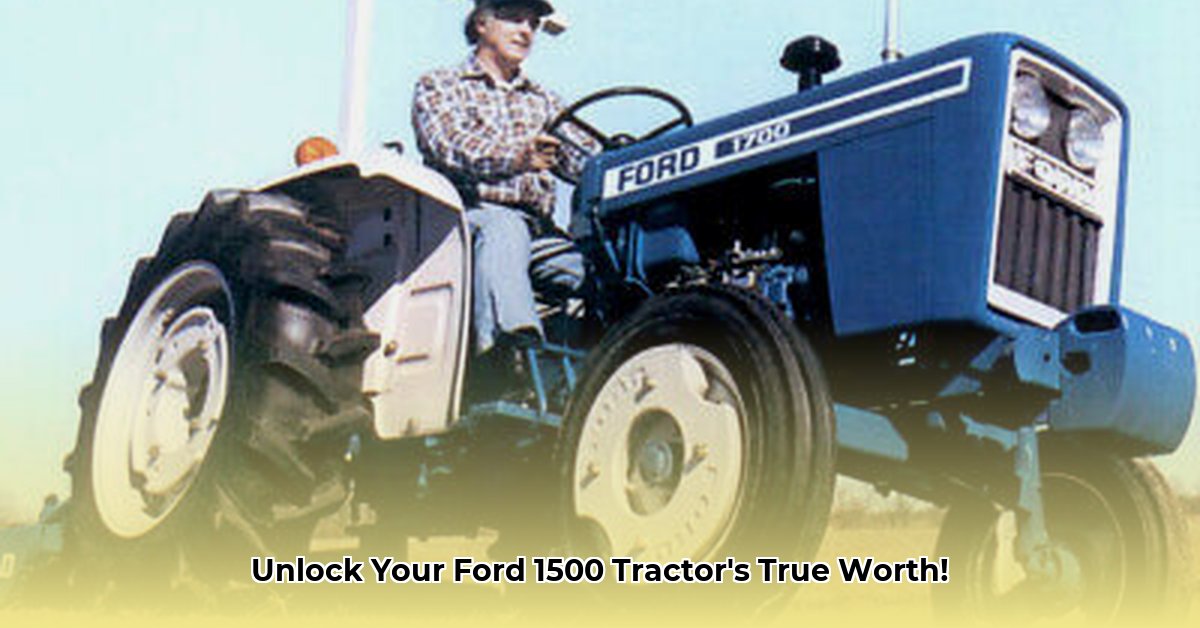
Determining the precise value of a used Ford 1500 tractor can be challenging due to the many factors influencing its worth. This comprehensive guide provides a step-by-step process to help buyers, sellers, and appraisers arrive at a fair market price. We'll cover key factors impacting value, inspection techniques, research methods, and effective pricing strategies. For additional valuation resources, check out this tractor blue book.
Key Factors Affecting Ford 1500 Tractor Value
Several critical elements significantly influence a Ford 1500's market value. Understanding these factors is paramount for accurate valuation.
Condition: The overall condition of the tractor is perhaps the single most important factor. A meticulously maintained tractor in excellent cosmetic and mechanical shape will command a significantly higher price than one that's rusty, damaged, and shows signs of neglect. Think of it like buying a classic car; pristine condition means a premium price.
Model Year: Generally, newer models are worth more. However, sought-after older models in exceptional condition can also fetch premium prices due to their rarity and collector appeal. The year of manufacture directly impacts value, with some years being more desirable than others.
Location: Geographic location plays a significant role. Areas with high demand or fewer comparable tractors available tend to see higher prices. Conversely, regions with plentiful supply might depress prices. Consider the local market dynamics.
Features and Attachments: Additional features and implements significantly boost a tractor's value. A Ford 1500 equipped with a front-end loader, specialized tools, or other modifications will generally sell for more than a standard model. Specific attachments increase functionality and thus, desirability.
Assessing Tractor Condition: A Detailed Inspection Checklist
A thorough inspection is crucial for determining a Ford 1500's true value. This step-by-step guide reveals what to look for:
Mechanical Inspection: Begin with a comprehensive evaluation of the engine, transmission, hydraulics, and power take-off (PTO). Listen for any unusual noises (knocking, grinding, squealing) indicating potential mechanical issues. Inspect fluid levels (oil, transmission fluid, hydraulic fluid) and check for leaks. A smooth-running engine is a key indicator of good condition.
Cosmetic Assessment: Next, carefully assess the tractor's external condition. Look for rust, dents, scratches, and damage to the body. Examine the paint for fading, chipping, or signs of poor repair. Assess the condition of the tires, seats, and controls in the operator station.
Operational Test (if possible): If feasible, operate the tractor, testing various functions. Note its starting capabilities, responsiveness, and overall performance. Any difficulties during operation significantly impact value. Does it start easily? Does it operate smoothly?
Document Review: Gather any available documentation, such as service records, repair invoices, and owner's manuals. A well-maintained history reflects positively on the tractor's value. These documents provide crucial information about its history.
Researching Comparable Sales: Utilizing Online Resources
The internet offers valuable tools for researching Ford 1500 tractor values. Many websites list agricultural equipment, often including sales history.
Identify Relevant Online Marketplaces: There are various websites specializing in used agricultural equipment listings. These platforms often show historical sales data.
Refine Your Search Parameters: Use filters to pinpoint Ford 1500 tractors similar to yours in terms of age, condition, features, and location. This helps you find truly comparable examples.
Analyze Sales Data: Review comparable sales data to understand the general price range. Remember that these figures provide a guide, not an absolute value. Always consider individual variations.
Broaden your Search: Don’t limit yourself to one source. Compare findings across multiple online resources to get the most comprehensive picture possible. Multiple sources provide a more accurate valuation range.
Pricing Strategies for Sellers: Maximizing Your Return
Effective pricing is essential for a successful sale. Here's how to approach it:
Conduct Thorough Market Research: Utilize the research methods described above to obtain a well-informed understanding of current market values for comparable Ford 1500 tractors.
Honest and Accurate Description: Be transparent about the tractor's condition, clearly stating any issues. An honest description builds trust and attracts serious buyers.
High-Quality Photos: Showcase your Ford 1500 with clear, well-lit photos highlighting its positive aspects. Impressive imagery enhances its appeal.
Competitive Pricing: Price your tractor competitively based on your research, ensuring it's in line with similar offerings. Overpricing can deter potential buyers.
Buying Strategies for Buyers: Securing a Fair Deal
Buying a used tractor requires caution and thoroughness. Consider these steps:
Comprehensive Inspection: Always conduct a detailed pre-purchase inspection (as outlined above) to identify potential problems and negotiate accordingly. This is crucial to avoid costly surprises.
Informed Negotiation: Armed with your market research, negotiate a fair price that reflects the tractor's condition and the current market value.
Professional Assessment (Optional): If you lack mechanical expertise, consider engaging a qualified mechanic to perform an independent inspection. This can be a worthwhile investment.
Ford 1500 Tractor Value Range (USD) – A General Guideline
The table below provides a general price range. Remember that actual values vary significantly based on condition, year, location, and features.
| Condition | Approximate Value Range (USD) |
|---|---|
| Excellent | $8,000 - $15,000 |
| Good | $5,000 - $10,000 |
| Fair | $3,000 - $6,000 |
| Poor | $1,000 - $3,000 |
This guide offers a framework for determining Ford 1500 tractor values. But remember that careful research and a thorough inspection are crucial for obtaining the most accurate assessment, whether you are buying or selling.